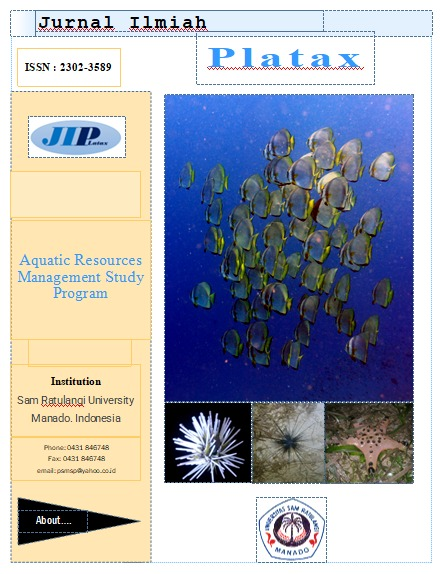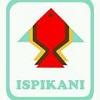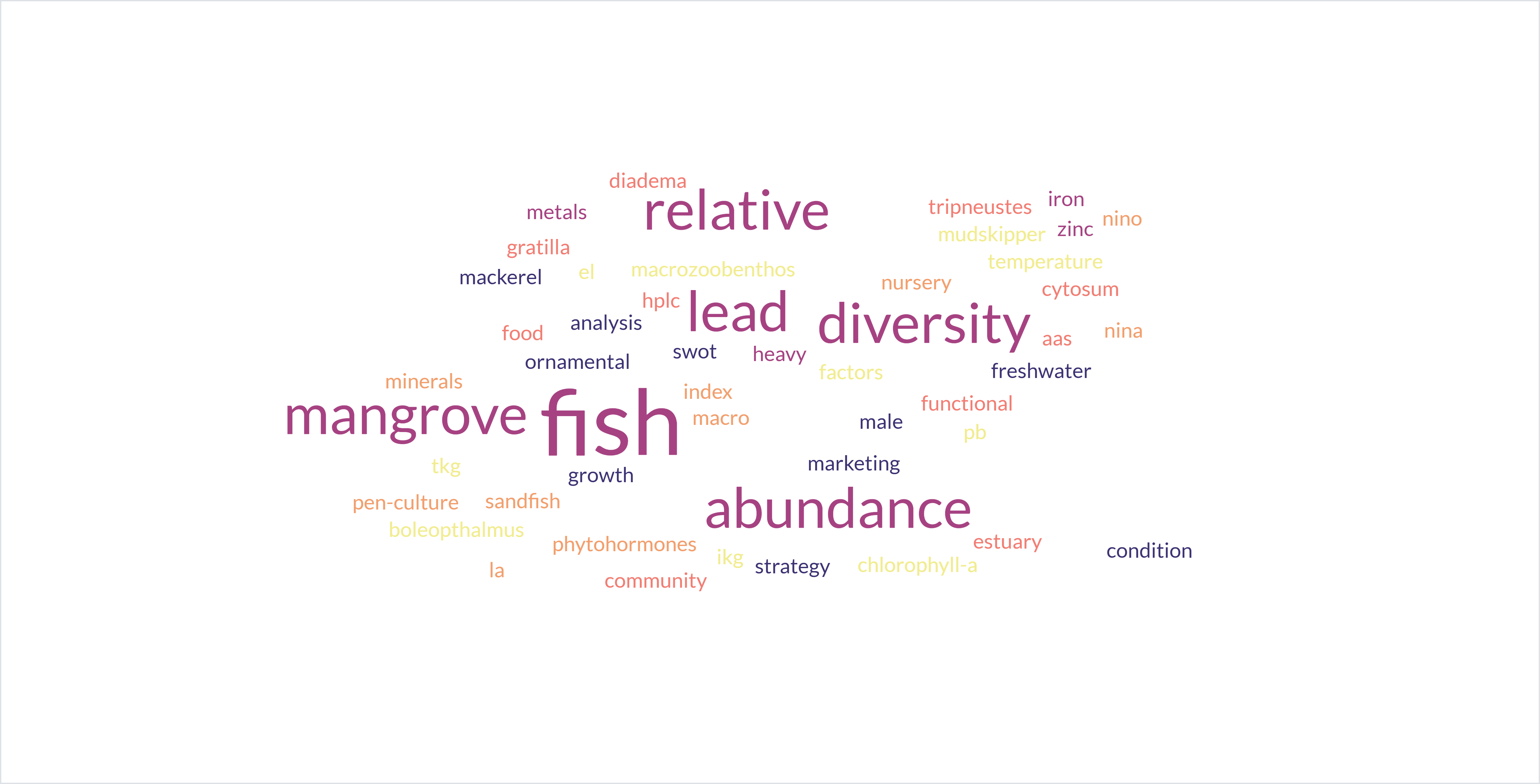Coral Recruitment And Transplantation To Support Coral Reef Ecosystem Recovery (Overview)
DOI:
https://doi.org/10.35800/jip.v12i1.55333Keywords:
coral recruitment, coral transplantation, coral reefAbstract
Coral reefs are massive deposits of calcium carbonate (CaCO3) produced by coral animals. Coral reefs in the water are easily damaged due to natural events and destrutive human activities in the water and the influence of upland. The purpose of this paper is to provide information related to the recovery of coral reef ecosystems through coral recruitment and coral transplantation and the role of the community. The method used is the quantitative method. Recruitment and transplantation use media as a place to attach or bind coral fragments. Coral recruitment is done by relying on the reproduction of the coral itself, while transplantation is done by taking coral fragments from the broodstock. The placement of coral recruitment and transplantation media needs to pay attention to water depth, brightness, substrate, sedimentation, and water current patterns. In addition, the government, community, and related parties are needed to handle damage and maintain and manage coral reef ecosystems for sustainability.
Keywords: Coral Recruitment; Coral Transplantation; Coral Reef
Abstrak
Terumbu karang merupakan endapan massif kalsium karbonat (CaCO3) yang dihasilkan oleh hewan karang . Terumbu karang di perairan mudah mengalami kerusakan akibat kejadian alam maupun kegiatan manusia yang bersifat destrutif di perairan maupun pengaruh dari lahan bagian atas (upland). Tujuan penulisan ini yaitu untuk memberikan informasi terkait dengan pemulihan ekosistem terumbu karang melalui rekrutmen karang dan transplantasi karang serta peran masyarakat. Metode yang digunakan yaitu metode kuantitatif. Rekrutmen dan transplantasi menggunakan media sebagai tempat penempelan maupun mengikat fragmen karang. Rekrutmen karang dilakukan dengan mengandalkan reproduksi dari karang itu sendiri, sedangkan transplantasi dilakukan dengan mengambil fragmen karang dari indukan. Lokasi penempatan media rekrutmen dan transplantasi karang perlu memperhatikan kedalaman perairan, kecerahan, substrat, sedimentasi dan pola arus perairan. Selain itu, peran pemerintah, masyarakat dan pihak terkait diperlukan untuk penanganan kerusakan, menjaga dan pengelolaan ekosistem terumbu karang untuk keberlanjutan.
Kata Kunci : Rekrutmen Karang; Transplantasi karang; Terumbu Karang
References
Abrar, M. (2011). Kelulusan Hidup Rekruitmen Karang (Scleractinia) di Perairan Gugus Pulau Pari, Kepulauan Seribu, Jakarta. Institute Pertanian Bogor.
Amin. (2009). Terumbu Karang: Aset yang Terancam (Akar Masalah dan Alternatif Solusi Penyelamatannya). Region, 1(2), 1–2.
Ammar, M. S. A., El-Gammal, F., Nassar, M., Belal, A., Farag, W., El-Mesiry, G., El-Hadad, K., Orabi, A., Abdelreheem, A., & Shaaban, A. (2013). Review: Current Trends In Coral Transplantation-an Approach To Preserve Biodiversity. Biodiversitas Journal of Biological Diversity, 14(1), 43–53. https://doi.org/10.13057/biodiv/d140107
Anthony, K. R. N., & Larcombe, P. (2000). Coral Reefs In Turbid Waters:Sediment-induced Stresses In Corals and Likely Mechanisms Of Adoption. Proceedings of the 9th International Coral Reef Symposium, I(October), 239–244. https://www.researchgate.net/publication/230604753%0ACoral
Arimbi, B. D., Arthana, I. W., & Ernawati, N. M. (2023). Analisis Laju Pertumbuhan Karang Acropora sp . Hasil Transplantasi di Pantai Geger. Current Trends in Aquatic Science, 6(1), 50–57.
Bachtiar, I. (2015). Reproduction Of Three Scleractinian Corals (Acropora cytherea , A . nobilis , Hydnophora rigida) in eastern Lombok Strait , Indonesia. ILMU KELAUTAN: Indonesian Journal of Marine Sciences, 6(March), 18–27. https://www.researchgate.net/publication/270893977%0AReproduction
Bachtiar, I., Abrar, M., & Budiyanto, A. (2012). Rekruitmen Karang Scleractinia di Perairan Pulau Lembata. Ilmu Kelautan, 17(1), 1–7.
Bukhari, B., Putra, R. D., & Kurniawan, D. (2021). Optimalisasi Penggnaan Waktu Pembersihan Untuk Suksesi Transplantasi Karang Acropora millepora di Perairan Makang Rapat, Bintan. Jurnal Kelautan Nasional, 16(2), 145–156.
Dalimunthe, H. I., Husaini, H., Manurung, V. R., Yudhiwinata, M. A., Harahap, M. P., Pahlevy, M. A., Adisusilo, M. N., Abdillah, M. F., Hanif, M., Florencia, S., Sazida, H., Tambunan, D., Abshar, M. T., Manurung, F., & Waruwu, B. K. (2023). Upaya Rehabilitasi Ekosistem Terumbu Karang Terdampak Tumpahan Minyak Di Desa Faekhua, Kecamatan Afulu, Kabupaten Nias Utara. Abdi Insani, 10(3), 1555–1568. https://doi.org/https://doi.org/10.29303/abdiinsani.v10i3.1066 PENDAHULUAN
Erwin, P. M., Song, B., & Szmant, A. (2008). Settlement Behavior Of Acropora Palmata Planulae : Effects Of Biofilm Age And Crustose Coralline Algal Cover. Coral Reef Symposium, 24, 1219–1224. https://www.researchgate.net/publication/249327906%0ASettlement
Fabricius, K. E. (2005). Effects Of Terrestrial Runoff On The Ecology Of Corals And Coral Reefs : Review And Synthesis Effects Of Terrestrial Runoff On The Ecology Of Corals And Coral Reefs : Review And Synthesis. Maine Pollution BUletin, 50, 125–146. https://doi.org/10.1016/j.marpolbul.2004.11.028
Ginting, J. (2023). Analisis Kerusakan Terumbu Karang dan Upaya Pengelolaannya. Jurnal Kelautan Dan Perikanan Terapan (JKPT), 1, 53. https://doi.org/10.15578/jkpt.v1i0.12066
Halisah, K. A. Z., Solichin, A., & Sabdaningsih, A. (2020). Kualitas Habitat Rekruitmen Juvenil Karang Di Perairan Pulau Kemujan , Karimunjawa. Buletin Oseanografi Marina, 9(2), 141–149. https://doi.org/10.14710/buloma.v9i2.31038
Hallock, P., Barnes, K., & Fisher, E. M. (2014). Coral-Reef Risk Assessment From Satellites To Molecules: A Multi-Scale Approach To Environmental Monitoring and Risk Assessment Of Coral Reef. Environmental Micropaleontology, Microbiology and Meiobenthology, 1, 11–39. https://www.researchgate.net/publication/237811397%0ACORAL-REEF
Haris, A., Rani, C., Tahir, A., Burhanuddin, A. I., Samawi, M. F., Tambaru, R., Werorilangi, S., Arniati, & Faisal, A. (2017). Survival And Growth of Transplantation of Ornament Coral Acropora sp in The Village of Tonyaman , Binuang District , Polewali Mandar Regency. Spermonde, 2(3), 1–8.
Harriot, V. J., & Fisk, D. A. (1988). Coral Transplantation As a Reef Management Option. International Coral Reef Symposium, 2, 375–379. https://www.researchgate.net/publication/267385903%0ACoral
James, M., Crabbe, C., & Smith, D. J. (2005). Sediment Impacts on Growth Rates of Acropora and Porites Corals From Fringing Reefs of Sulawesi , Indonesia. Coral Reefs, 24, 437–441. https://doi.org/10.1007/s00338-005-0004-6
Johan, O., Soedharma, D., & Suharsono, S. (2008). Tingkat Keberhasilan Transplantasi Karang Batu di Pulau Pari Kepulauan Seribu, Jakarta. Ris.Akuakultur, 3(2), 289–300.
Kisworo, H., Wijayanti, D. P., & Munasik, M. (2012). Studi Penempelan Juvenil Karang Pocillopora Damicornis Pada Jenis Substrat Kolektor Dan Zona Terumbu Yang Berbeda Di Pulau Panjang, Kabupaten Jepara. Journal of Marine Research, 1(1), 129–136. http://ejournal-s1.undip.ac.id/index.php/jmr
Komarudin, A. N., Munasik., & Marwoto, J. (2013). Prediksi Waktu Spawning Karang Acropora Pada Musim Peralihan Kedua di Pulau Sambangan Kepulauan Karimunjawa. Journal of Marine Research, 2(4), 84–93. http://ejournal-s1.undip.ac.id/index.php/jmr%0APREDIKSI
Malik, A., Minsarin, L. O. A., & Anzani, L. (2023). Pengaruh Perbedaan Modul Transplantasi Karang Terhadap Pertumbuhan Karang di Pulau Pramuka. Juvenil, 4(2), 90–103. https://journal.trunojoyo.ac.id/juvenil
Mangubhai, S., Harrison, P. L., & Obura, D. O. (2007). Patterns of coral larval settlement on lagoon reefs in the Mombasa Marine National Park and. Marine Ecology Progress Series, 348, 149–159. https://doi.org/10.3354/meps07090
Mcclanahan, T. R. (2004). The Relationship Between Bleaching and Mortality of Common Corals. Marine Biology, 144, 1239–1245. https://doi.org/10.1007/s00227-003-1271-9
Mcleod, E., Anthony, K. R. N., Mumby, P. J., Maynard, J., Beeden, R., Graham, N. A. J., Heron, S. F., Hoegh-Guldberg, O., Jupiter, S., MacGowan, P., Mangubhai, S., Marshall, N., Marshall, P. A., McClanahan, T. R., Mcleod, K., Nyström, M., Obura, D., Parker, B., Possingham, H. P., … Tamelander, J. (2019). The Future of Resilience-based Management In Coral Reef Ecosystems. Journal of Environmental Management, 233, 291–301. https://doi.org/10.1016/j.jenvman.2018.11.034
Muhlis. (2019). Pertumbuhan Kerangka Karang Acropora di Perairan Sengigi Lombok. Biologi Tropis, 19(1), 14–18. https://doi.org/http://dx.doi.org/10.29303/jbt.v19i1.940
Munasik. (2002). Reproduksi Seksual Karang Di Indonesia: Suatu Kajian. Pengelolaan Sumberdaya Pesisir Dan Lautan Indonesia, 3, 1–10.
Munasik., Suharsono., Situmorang, J., & Kamiso, H. N. (2014). Kerapatan dan Kelulushidupan pada Rekrutmen Karang Pocillopora damicornis. 19(September), 171–180.
Munasik., & Widjatmoko, W. (2004). Reproduksi K arang Acropora aspera Karang di Pulau Panjang , Jawa Tengah : I . Gametogenesis. Ilmu Kelautan, 9(4), 211–216.
Muzaki, F. K., Muhajir, F., Ariyanto, G., & Rimayanti, R. (2010). Kondisi Terumbu Karang di Perairan Bangka, Provinsi Bangka Belitung. 1–11.
Muzaki, F. K., Saptarini, D., Azizah, I. R., Sari, I. K., & Pramono, A. T. E. (2020). Survival and Growth Of Acropora Millepora Coral Fragments Transplanted In Turbid Water Of Sepulu, Bangkalan – Madura. Ecology, Environment, and Conservation, 26(June), S26–S31.
Novriadi, N., Nurhayu, W., Darmawa, A., Sari, D. A., Gurning, A. R., Afrizal, M., & Malik, M. A. (2023). Pelatihan Survey Ekosistem Dan Transplantasi Terumbu Karang Di Desa Pahawang. BERNAS, 4(4), 3401–3406. https://doi.org/10.31949/jb.v4i4.6379
Nugroho, B. S., Zuhry, N., Kusnandar, K., Simanjuntak, S. W., Alamsyah, H. K., & Karissa, P. T. (2022). Biorock ® Technology Application To The Growth And Acropora Corals Growth Rate. Internasional Conference on Sustainability Fisheries and Marine, 1–8. https://doi.org/10.1088/1755-1315/1147/1/012003
Nugroho, F., Zamani, N. P., & Madduppa, H. (2018). Pengaruh Kandungan Organik Sedimen Terhadap Keanekaragaman Karang di Kepulauan Karimunjawa, Indonesia. Ilmu Dan Teknologi Kelautan Tropis, 10(1), 79–86.
Nurhasima, N., Nugraha, A. H., & Kurniawan, D. (2021). Rekrutmen Karang Keras (Scleractinia) Berdasarkan Zona Geomorfologi Di Perairan Pulau Bintan, Kepulauan Riau. Ilmu Dan Teknologi Kelautan Tropis, 13(2), 269–281. https://doi.org/https://doi.org/10.29244/jitkt.v13i2.34551
Oli, A. P., Roeroe, K. A., Paruntu, C. P., Kusen, J. D., Manembu, I. S., & Mandagi, S. V. (2022). Studi Rekrutmen Karang Keras ( Scleractinia ) Di Perairan Molas Kota Manado. Ilmiah PLATAX, 10(1), 61–69. http://ejournal.unsrat.ac.id/index.php/platax
Onaka, S., Prasetyo, R., Endo, S., & Yoshi, I. (2013). Large-Scale Coral Transplantation In Artificial Substrates At a Shallow Lagoon In Kuta Beach, Bali, Indonesia. Galaxea, 336–342. https://doi.org/10.3755/galaxea.15.336
Parenden, D., Jompa, J., Rani, C., Renema, W., & Tuhumena, J. R. (2023). Biodiversity of Hard Coral (Scleractinia) and Relation To Environmental Factors Turbid Waters In Spermonde Islands, South Sulawesi, Indonesia. Biodiversitas, 24(9), 4635–4643. https://doi.org/10.13057/biodiv/d240903
Rahman, A., Haris, A., & Jamaluddin, J. (2014). Pola Rekrutmen Karang Scleractinia Pada Kondisi Lingkungan Berbeda. Sains Dan Teknologi, 14(3), 209–219.
Rani, C., Tahir, A., Jompa, J., Faisal, A., Yusuf, S., Werorilangi, S., & Anrniati, A. (2017). Keberhasilan Rehabilitasi Terumbu Karang Akibat Peristiwa Bleaching Tahun 2016 Dengan Teknik Transplantasi. SPERMONDE, 3(1), 13–19.
Romimohtarto, K., & Juwana, S. (2007). Biologi Laut : Ilmu Pengetahuan Tentang Biota Laut (3rd ed.). PT. Djambatan.
Safir, M., Mansyur, K., Serdiati, N., & Tahya, A. M. (2021). Pendampingan Transplantasi Terumbu Karang Berbasis Rumah Ikan Di Perairan Teluk Palu Pasca Bencana. Krida Cendekia, 01(05), 15–21.
Sakti, W. I. (2023). Peran Masyarakat Sipil Dalam Pengelolaan Lingkungan Pesisir. Kelautan Dan Perikanan Terapan, 87–90. https://doi.org/10.15578/jkpt.v1i0.12058 Jurnal
Setyadi, E. (1996). Studi Tentang Rekruitmen Karang Untuk Terumbu Karang Buatan Dengan Berbagai Tipe Substrat Kolektor di Pulau Panjang dan Kepulauan Karimunjawa, Jepara. Universitas Diponegoro.
Siringoringo, R. M., Hadi, T. A., Purnama, N. W., Abrar, M., & Munasik, M. (2020). Distribution and Community Structure of Coral Reefs in The West Coast of Sumatra , Indonesia. Ilmu Kelautan, 24(1), 51–60. https://doi.org/10.14710/ik.ijms.24.1.51.60
Subhan, B., Madduppa, H., Arafat, D., Soedharma, D., Kelautan, I., Pertanian Bogor, I., Biosistematik a, L., Kelautan, B., Ilmu, D., Kelautan, T., & Bogor, P. (2014). Bisakan Transplantasi Karang Perbaiki Ekosistem Terumbu Karang? Risalah Kebijakan Pertanian Dan Lingkungan, 1(3), 159–164.
Subhan, S., & Afu, L. O. A. (2017). Pengaruh Laju Sedimentasi Terhadap Rekrutmen Karang di Teluk Kendari, Provinsi Sulawesi Tenggara. Manusia Dan Lingkungan, 24(2), 73–80. https://doi.org/10.22146/jml.23070
Suharsono. (2008). Jenis-Jenis Karang di Indonesia. LIPI Press, anggota Ikapi.
Suharsono, Siringoringo, R. M., Hadi, T. A., Giyanto, G., Tuti, Y., Budiyanto, A., & Sulha, S. (2013). Perkembangan Teknik Transplantasi Karang Di Indonesia. Pusat Penelitian Oseanografi-LIPI.
Thamrin, T. (2017). Karang: Biologi Reproduksi & Ekologi. UR Press.Pekanbaru
Tioho, H., Tokeshi, M., & Nojima, S. (2001). Experimental Analysis Of Recruitment In a Scleractinian Coral At High Latitude. Marine Ecology Progress Series, 213, 79–86.
Tuhumena, J. R., Tapilatu, R. F., & Boli, P. (2019). The Effect Of Type And Duration Of Substrate Collector Placement to the Coral Genus Recruitment In Saleo Beach Area, Dampier Strait, Raja Ampat, Indonesia. AACL Bioflux, 12(5), 1643–1652.
Veron, J. E. N. (2000). Corals Of the World 1 and 3. Institute Of Marine Science and CRR Qld Pty Ltd.
Westmacott, S., Teleki, K., Wells, S., & Jordan, W. (2000). Pengelolaan Terumbu Karang yang Telah Memutih dan Rusak Kritis (J. H. Steffen (ed.)). The Nature Conservation Bureau.
Wijaya, A. A. N. A. I., Kristyawan, I. P. A., & Dharma, I. G. B. S. (2024). Pertumbuhan Crustose Coralline Algae ( CCA ) pada Substrat Keramik dengan Komposisi dan Jenis Material Penyusun yang Berbeda. Teknologi Lingkungan, 25(1), 80–87. ejournal.brin.go.id/JTL
Williams, S. L., Sur, C., Janetski, N., Hollarsmith, J. A., Rapi, S., Barron, L., Heatwole, S. J., Yusuf, A. M., Yusuf, S., Jompa, J., Jamaluddin, J., & Mars, F. (2019). Large-scale coral reef rehabilitation after blast fishing in Indonesia. Restoration Ecology, 27(2), pp.46. https://doi.org/10.1111/rec.12866
Witomo, C. M., Firdaus, M., Soejarwo, P. A., Muawanah, U., Ramadhan, A., Pramoda, R., & Koeshedrajana, S. (2017). Estimasi Kerugian Ekonomi Kerusakan Terumbu Karang Akibat Tabrakan Kapal Caledonian Sky Di Raja Ampat. Buletin Ilmiah “Marina” Sosial Ekonomi Kelautan Dan Perikanan, 3(1), 7–19.
Yucharoen, M., Thammachote, S., Jaroenpon, A., Lamka, S., & Thongtham, N. (2013). Coral transplantation in turbid waters at Rad Island, Phuket, Thailand. Galaxea, Journal of Coral Reef Studies, 15(Supplement), 343–350. https://doi.org/10.3755/galaxea.15.343
Zurba, N. (2019). Pengenalan Terumbu Karang, Sebagai Pondasi Utama Laut Kita. Unimal Press.
Zweifler, A., O’Leary, M., Morgan, K., & Browne, N. K. (2021). Turbid Coral Reefs: Past, Present and Future-A Review. Diversity, 13(June), 1–23. https://doi.org/10.3390/d13060251.
Downloads
Published
How to Cite
License
Copyright (c) 2024 Jeremias Tuhumena, Delima, Lindon Pane, Lely, Dedi Parenden, Lolita Tuhumena

This work is licensed under a Creative Commons Attribution-NonCommercial 4.0 International License.
COPYRIGHT
Authors who publish with this journal agree to the following terms:
Authors hold their copyright and grant this journal the privilege of first publication, with the work simultaneously licensed under a Creative Commons Attribution License that permits others to impart the work with an acknowledgment of the work's origin and initial publication by this journal.
Authors can enter into separate or additional contractual arrangements for the non-exclusive distribution of the journal's published version of the work (for example, post it to an institutional repository or publish it in a book), with an acknowledgment of its underlying publication in this journal.
Authors are permitted and encouraged to post their work online (for example, in institutional repositories or on their website) as it can lead to productive exchanges, as well as earlier and greater citation of the published work (See The Effect of Open Access).




















